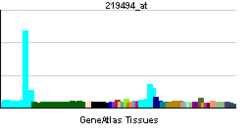RAD54B
| RAD54B | ||||||
|---|---|---|---|---|---|---|
| Identifiers | ||||||
| Aliases | RAD54B, RDH54, RAD54 homolog B (S. cerevisiae) | |||||
| External IDs | MGI: 3605986 HomoloGene: 8240 GeneCards: RAD54B | |||||
| RNA expression pattern | ||||||
 | ||||||
| More reference expression data | ||||||
| Orthologs | ||||||
| Species | Human | Mouse | ||||
| Entrez | ||||||
| Ensembl | ||||||
| UniProt | ||||||
| RefSeq (mRNA) | ||||||
| RefSeq (protein) | ||||||
| Location (UCSC) | Chr 8: 94.37 – 94.48 Mb | Chr 4: 11.56 – 11.62 Mb | ||||
| PubMed search | [1] | [2] | ||||
| Wikidata | ||||||
| View/Edit Human | View/Edit Mouse |
DNA repair and recombination protein RAD54B is a protein that in humans is encoded by the RAD54B gene.[3][4][5]
The protein encoded by this gene belongs to the DEAD-like helicase superfamily. It shares similarity with Saccharomyces cerevisiae RAD54 and RDH54, both of which are involved in homologous recombination and repair of DNA. This protein binds to double-stranded DNA, and displays ATPase activity in the presence of DNA. This gene is highly expressed in testis and spleen, which suggests active roles in meiotic and mitotic recombination. Homozygous mutations of this gene were observed in primary lymphoma and colon cancer.[5]
Interactions
RAD54B has been shown to interact with RAD51.[4]
References
- ↑ "Human PubMed Reference:".
- ↑ "Mouse PubMed Reference:".
- ↑ Hiramoto T, Nakanishi T, Sumiyoshi T, Fukuda T, Matsuura S, Tauchi H, Komatsu K, Shibasaki Y, Inui H, Watatani M, Yasutomi M, Sumii K, Kajiyama G, Kamada N, Miyagawa K, Kamiya K (Jun 1999). "Mutations of a novel human RAD54 homologue, RAD54B, in primary cancer". Oncogene. 18 (22): 3422–6. doi:10.1038/sj.onc.1202691. PMID 10362364.
- 1 2 Tanaka K, Hiramoto T, Fukuda T, Miyagawa K (Sep 2000). "A novel human rad54 homologue, Rad54B, associates with Rad51". J Biol Chem. 275 (34): 26316–21. doi:10.1074/jbc.M910306199. PMID 10851248.
- 1 2 "Entrez Gene: RAD54B RAD54 homolog B (S. cerevisiae)".
Further reading
- Miyagawa K, Tsuruga T, Kinomura A, et al. (2002). "A role for RAD54B in homologous recombination in human cells.". EMBO J. 21 (1–2): 175–80. doi:10.1093/emboj/21.1.175. PMC 125815
 . PMID 11782437.
. PMID 11782437. - Tanaka K, Kagawa W, Kinebuchi T, et al. (2002). "Human Rad54B is a double-stranded DNA-dependent ATPase and has biochemical properties different from its structural homolog in yeast, Tid1/Rdh54". Nucleic Acids Res. 30 (6): 1346–53. doi:10.1093/nar/30.6.1346. PMC 101365
 . PMID 11884632.
. PMID 11884632. - Strausberg RL, Feingold EA, Grouse LH, et al. (2003). "Generation and initial analysis of more than 15,000 full-length human and mouse cDNA sequences". Proc. Natl. Acad. Sci. U.S.A. 99 (26): 16899–903. doi:10.1073/pnas.242603899. PMC 139241
 . PMID 12477932.
. PMID 12477932. - Sehorn MG, Sigurdsson S, Bussen W, et al. (2004). "Human meiotic recombinase Dmc1 promotes ATP-dependent homologous DNA strand exchange". Nature. 429 (6990): 433–7. doi:10.1038/nature02563. PMID 15164066.
- Gerhard DS, Wagner L, Feingold EA, et al. (2004). "The status, quality, and expansion of the NIH full-length cDNA project: the Mammalian Gene Collection (MGC)". Genome Res. 14 (10B): 2121–7. doi:10.1101/gr.2596504. PMC 528928
 . PMID 15489334.
. PMID 15489334. - Rual JF, Venkatesan K, Hao T, et al. (2005). "Towards a proteome-scale map of the human protein-protein interaction network". Nature. 437 (7062): 1173–8. doi:10.1038/nature04209. PMID 16189514.
- Wesoly J, Agarwal S, Sigurdsson S, et al. (2006). "Differential contributions of mammalian Rad54 paralogs to recombination, DNA damage repair, and meiosis". Mol. Cell. Biol. 26 (3): 976–89. doi:10.1128/MCB.26.3.976-989.2006. PMC 1347043
 . PMID 16428451.
. PMID 16428451. - Sarai N, Kagawa W, Kinebuchi T, et al. (2006). "Stimulation of Dmc1-mediated DNA strand exchange by the human Rad54B protein". Nucleic Acids Res. 34 (16): 4429–37. doi:10.1093/nar/gkl562. PMC 1636354
 . PMID 16945962.
. PMID 16945962. - Ewing RM, Chu P, Elisma F, et al. (2007). "Large-scale mapping of human protein-protein interactions by mass spectrometry". Mol. Syst. Biol. 3 (1): 89. doi:10.1038/msb4100134. PMC 1847948
 . PMID 17353931.
. PMID 17353931. - Bryś M, Nowacka-Zawisza M, Romanowicz-Makowska H, et al. (2007). "Loss of heterozygosity in the RAD54B region is not predictive for breast carcinomas". Pol J Pathol. 58 (1): 3–6. PMID 17585536.
This article is issued from Wikipedia - version of the 6/3/2016. The text is available under the Creative Commons Attribution/Share Alike but additional terms may apply for the media files.